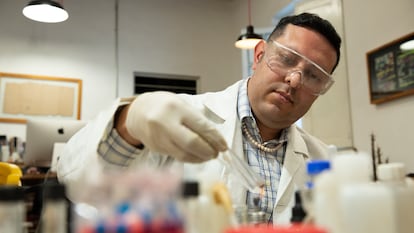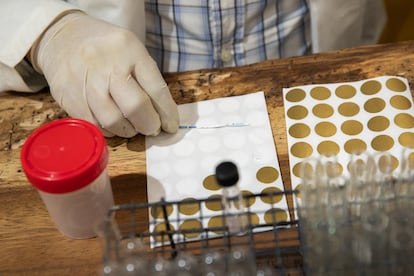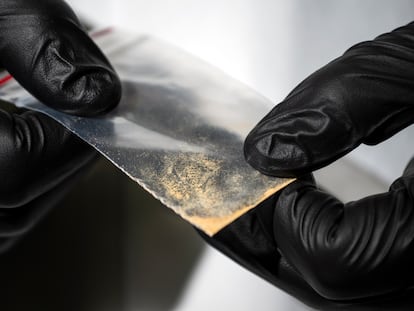Dewormer, rat poison and suspected fentanyl: What adulterated drugs in Mexico City are hiding
Fear that cocaine and ecstasy will be laced with lethal doses of opiates or other dangerous substances has unleashed a wave of hysteria among drug users

Carlos has been trying to reduce his cocaine use since October, out of fear and precaution. He usually takes it on weekends in Mexico City with his friends, but they began to notice that the effects were different. They were more intense, shorter and more addictive. That’s when panic broke out. “Maybe it’s got fentanyl in it,” Carlos wrote in a chat with friends late last year.
After a study found that half of the cocaine tested at a festival near Mexico City was adulterated with fentanyl, Carlos and his friends decided to stop taking it so regularly. “Cocaine that’s been cut has been going around for about eight months now, trust me,” he says. He is part of the group of consumers who have attended a free, community-based substance analysis laboratory set up by the DiVU association. Nervous and a little worried, they bring plastic bags of white powder or pills with them. They are all here for the same thing: to find out if the drugs on the capital’s streets are cut with fentanyl.
Carlos’ name has been changed to safeguard his anonymity. None of the attendees at this meeting want to be identified because of the stigma that still surrounds recreational drug use. However, in this environment they can talk openly about their habits, their dealers, even the nature of the trips they experience with two specialist chemists who analyze the substances to see if they have been adulterated. In just two hours, the chemists have found several doses of acid mixed with amphetamine, MDMA, that have been laced with unknown substances to increase the volume. There are also several samples of cocaine adulterated with levamisole, a dangerous dewormer for veterinary use. But there is no trace of the dreaded fentanyl.
The powerful, cheap opiate is 50 times stronger than heroin and 100 times stronger than morphine. It leapt to the streets after being used as a painkiller in operating rooms and is causing a public health crisis in the United States, where it has already caused more than 70,000 overdose deaths. Despite the fact that U.S. Republicans blame Mexico for being a laboratory and distributor of fentanyl, Mexican health authorities, however, say that the drug has not reached the national market.
“Fortunately, it is not yet a major public health problem in Mexico, and we do not want it to be. That is why we are acting on it,” said the Undersecretary of Prevention and Health Promotion, Hugo López-Gatell Ramírez, last September. It is true that there is no registry with official consumption data, but in border cities, fentanyl is already a problem.
An investigation tested 51 drug samples from 40 users at an electronic music festival near Mexico City in 2022. Although none of the volunteers who took their drugs for testing expected them to test positive for fentanyl, it showed up in 14 of 22 samples tested for MDMA, and two out of four doses of cocaine. Silvia Cruz, a co-author of the study and one of the first researchers to do fieldwork on fentanyl in Mexico, insists that it is better to alert the public.
“There could be false positives. We did our best to reduce them, and yet we found two positive cocaine samples without confirmatory analysis. Where it occurs most is in methamphetamine,” she says in a telephone interview. The expert warns that in northern Mexico, 80% of the heroin samples tested contained fentanyl, so the possibility that this substance is circulating in the center of the country is “very high.” “Fentanyl is getting dangerously close, there’s a risk. If we assume it’s not there, and we don’t have the antidote, people are going to die,” she says.

For his part, Ruben Diazconti, anthropologist and head of the harm reduction program at the Condesa Clinic, calls for calm. “We believe that the festival results of the study are false positives, possibly test strips were used.” This test, which can be purchased online, can give questionable results if the drug has a precise combination of components or is very high in purity. “People who use heroin in the city are the most exposed [to fentanyl] and have not raised any warning,” he says.
Diazconti adds that if it were true that fentanyl was present in more than half of the samples, there would have been an alarming wave of overdoses, especially if users did not know they were taking fentanyl. He is concerned about other adulterants that are being found in narcotics, such as levamisole, which causes necrosis in the nasal passages. EL PAÍS contacted the Ministry of Health of Mexico City and the Institute of Addictions and Prevention to discuss the presence of the fentanyl and other adulterants on the streets of the capital, but received no response.
The lack of an antidote
While academics are still looking for consensus in their perception of the fentanyl crisis in Mexico, there is already hysteria is among consumers. In early February, the suspicious death of a well-known DJ in the city unleashed a wave of alarm on social media. In these warnings — written mostly in English because they were intended for foreigners visiting the capital during Art Week — social media advised people to only buy drugs from known sources, to avoid cocaine and to carry naloxone, a medication that serves as an antidote for opioid overdoses. Naloxone is freely available to buy in the United States, but it is very difficult to find in Mexico because it is classified as a medication with psychotropic effects.
One of the people at the DiVU community testing center says that when he saw those messages on Instagram and Twitter, he preferred to be cautious and take his MDMA to be tested. “The drug traffickers say in their banners that they are not going to sell fentanyl in Mexico, but they also say that they are not going to kill and we already know what happens,” he says, worried. At the end of last year, different criminal cartels made these pledges on banners that were put up in different cities on the border. At the testing center, people are also advised to ask acquaintances who are traveling to the northern neighbor to bring back naloxone, and keep the treatment close by when they consume drugs.
Astron Martínez, a social activist and scientific communicator who works at DiVU, argues there are not enough studies to determine the presence of fentanyl in Mexico. The civil association where he works carries out voluntary testing, but they have not tested more than 100 samples. He estimates that fentanyl has been found in one in every 25 of them. “The data is being underestimated. Due to the political narrative, there is no real data, we do not have autopsies, nor drug records,” he explains.
The RIA Institute, another key organizations in public drug policies, is also doing periodic analysis of substances. They have so far only tested a few samples, and have so far not found fentanyl. “We need more data and analysis services with greater scope and protection for the user. Otherwise, we run the risk of focusing too much on the alleged fentanyl warning and paying less attention to other proven and high-risk substances, such as methamphetamine,” adds Zara Snapp, director of the organization.
The experts consulted for this report agree that authorities are unwilling to document cases of drug consumption and overdoses. However, Martínez recognizes that thanks to social media, there is more demand for testing. He and his team have noticed this in the shortage of analytical tests, which are also driving up the price of the reagents used in the laboratory.
Caution at festivals
Panic over fentanyl has not only been seen in central Mexico, but also in music festivals, where, for the past five years, tents with small laboratories have been set up to carry out free drug tests. In these spaces, organizers have noticed that attendees are no longer hesitant to approach and have their substances tested. Monse Castera, cultural promoter at the Ceremonia festival, explains that the event did not previously test for fentanyl. “In the results from other years, there was rat poison in ecstasy,” he says, adding that and the event does not promote drug consumption, but rather safety.
This year, the festival is going to include opioids in its analysis. “If you don’t want anything to happen to you, it’s better not to consume drugs, but the use of recreational drugs should be a right for entertainment. From prohibition and negativity, it becomes a taboo topic and that is the problem, so we are not going to stop doing it,” he says. Castera adds that at a private party he organized during Art Week, they carried out tests and of 22 samples analyzed, one tested positive for fentanyl and another was a false positive. “The key to preventing accidents is communication. Talking about drugs without taboo and fear,” he says.
A woman in charge of an electronic music festival — who prefers not to give her name or the name of the event — indicates that of the almost 10,000 people who attended last year’s event, 370 brought substances to be analyzed and none tested positive for fentanyl. “There were substances not detected, because they did not fall within the parameters of those that we know exist. We also see many drugs mixed with other things, some with opposite effects,” she warns.
These are the prevention policies that specialists like Silvia Cruz are encouraging, given the impact of the fentanyl in northern Mexico. “We are not looking for consumer persecution, we are looking for emergency services. We better prepare, right? In the north of the country the epidemic is here to stay, the probability of it expanding is very high. People move around, and we have a lot of U.S. tourism,” she says.

Sign up for our weekly newsletter to get more English-language news coverage from EL PAÍS USA Edition
Tu suscripción se está usando en otro dispositivo
¿Quieres añadir otro usuario a tu suscripción?
Si continúas leyendo en este dispositivo, no se podrá leer en el otro.
FlechaTu suscripción se está usando en otro dispositivo y solo puedes acceder a EL PAÍS desde un dispositivo a la vez.
Si quieres compartir tu cuenta, cambia tu suscripción a la modalidad Premium, así podrás añadir otro usuario. Cada uno accederá con su propia cuenta de email, lo que os permitirá personalizar vuestra experiencia en EL PAÍS.
¿Tienes una suscripción de empresa? Accede aquí para contratar más cuentas.
En el caso de no saber quién está usando tu cuenta, te recomendamos cambiar tu contraseña aquí.
Si decides continuar compartiendo tu cuenta, este mensaje se mostrará en tu dispositivo y en el de la otra persona que está usando tu cuenta de forma indefinida, afectando a tu experiencia de lectura. Puedes consultar aquí los términos y condiciones de la suscripción digital.
More information
Archived In
Últimas noticias
Welcome to the post-religion era: The idea of Christianity as the absolute truth has become obsolete
‘I thought you would like it’: The risky sexual practice popularized by TV shows and TikTok
The digitalization of tourism: ‘They promise experiences and gave us the worst possible one’
Mexican peso defies uncertainty with forecasts of a new period of stability in 2026
Most viewed
- Sinaloa Cartel war is taking its toll on Los Chapitos
- Reinhard Genzel, Nobel laureate in physics: ‘One-minute videos will never give you the truth’
- Oona Chaplin: ‘I told James Cameron that I was living in a treehouse and starting a permaculture project with a friend’
- Why the price of coffee has skyrocketed: from Brazilian plantations to specialty coffee houses
- Silver prices are going crazy: This is what’s fueling the rally











































